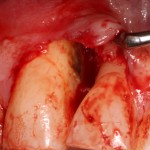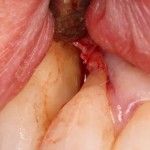- Bacterial induced bone loss.
- Bacteria removal
Facts About Gum Disease
Periodontitis (gum disease / bone loss) is a multifactorial bacterial induced chronic inflammatory disease that effects approximately 50% of the population over 30 years old in the United States. Gum disease results in the destruction of the supporting bone around teeth, and is usually pain free. It is usually pain-less in its initial treatable stages. Therefore, many patients are not motivated to seek treatment until their disease is in the more advance stages. The dilemma becomes that if the disease isn’t diagnosed and treated in the initial stages, than the only solution is tooth removal due to severe bone loss.
The irony about gum disease is that it causes chronic inflammation and patients experience bleeding, swelling, recession, and no pain. The exact reason why patients don’t experience pain during the initial phases of gum disease progression isn’t completely understood. However, it has been estimated that the release of neuropeptides from stimulated peripheral sensory nerves are to blame. Pain fibers that innervate the tissues of the periodontium (gum tissue) are immuno-reactive (stimulates) to these neuropeptides. It is theorized that the abundance and lack of neuropeptides directly effect the pain fibers and their ion channels, resulting in lack of pain experienced by a patient with gum disease.
As a proud diplomate of the American Board of Periodontology, I’m privileged to treat patients with all forms of gum disease in Oklahoma City and surrounding areas.





 by
by 


